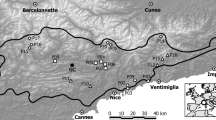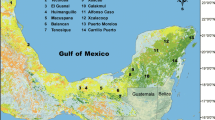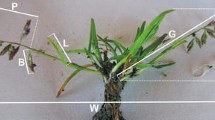Abstract
Although the perennial grass Dactylis glomerata L. has established dominant populations in Japan since its introduction in the 1870s, there have been marked reductions in its abundance in southern and northeastern regions. In order to examine the effects of climatic factors on distribution and differentiation of the naturalized populations of D. glomerata, abundance of 26 populations over a distance of 1500 km along a latitudinal gradient was recorded at each site, and life-history traits of each population were measured in a common garden. It was found that the reduction in abundance was related to the mean summer temperature in southern regions and to the lowest temperature before snow cover in northeastern regions. Recent climatic records in Japan show an increase in the mean summer temperature but no apparent changes in the lowest temperature before snow cover. These data suggest that, assuming the recent trend in climatic changes continues, the population abundance will decrease in southern regions and will change little in the northeastern regions. Germination speed, leaf width and reproductive allocations showed clinal variation over a geographical range, and the southern populations had more rapid germination, narrower leaves and lower reproductive allocation than did the northern populations. On the other hand, seed size and germination date showed margin-center differentiation. Marginal populations in both distributional borders had smaller seeds and lower germination rates than did the central populations.
Similar content being viewed by others
References
Baker B.S. and Jung G.A. 1968. Effects of environmental conditions on the growth of four perennial grasses. I. Response to controlled temperature. Agronomy Journal 60: 155–158.
Bazzaz F.A. 1996. Plants in Changing Environments. Cambridge University Press, Cambridge.
Begon M., Harper J.L. and Townsend C.R. 1996. Ecology: Individuals, Populations and Communities. 3rd edn. Blackwell Scientific Publications, Oxford.
Borrill M. 1976. Temperate grasses. In: Simmonds N.W. (ed.), Evolution of Crop Plants. Longman, London, pp. 137–142.
Cooper J.P. 1963. Species and population differences in climatic response. In: Evans L.T. (ed.), Environmental Control of Plant Growth. Academic Press, New York, pp. 381–403.
Endler J. 1986. Natural Selection in the Wild. Princeton University Press, Princeton.
Farrar J. and Gunn S. 1998. Allocation: Allometry, Acclimation-and Alchemy? In: Lambers H., Poorter H. and Van Vuuren M.M.I. (eds), Inherent Variation in Plant Growth, Physiological Mechanisms and Ecological Consequences. Backhuys Publishers, Leiden, pp. 183–198.
Fischer M. and Matthies D. 1998. Effects of population size on performance in the rare plant Dentianella germanica. Journal of Ecology 86: 195–204.
Gauthier P., Lumaret R. and Bedecarrals A. 1998. Ecotypic differentiation and coexistence of two parapatric tetraploid subspecies of cocksfoot (Dactylis glomerata) in the Alps. New Phytologist 139: 741–750.
Givnish T.J. and Vermeij G.J. 1976. Sizes and shapes of liane leaves. American Naturalist 100: 743–778.
Givnish T.J. 1986. Optimal stomatal conductance, allocation of energy between leaves and roots, and the marginal cost of transpiration.In: Givnish T.J. (ed.), On the Economy of Plant Form and Function. Cambridge University Press, Cambridge, pp. 171–213.
Givnish T.J. 1987. Comparative studies of leaf form: assessing the relative roles of selective pressures and phylogenetic constraints.New Phytologist 106: 131–160.
Hoffmann A.A. and Blows M.W. 1994. Species borders: ecological and evolutionary perspectives. Trends in Ecology & Evolution 9: 223–227.
Hoffmann A.A. and Parso P.A. 1997. Extreme Environmental Change and Evolution. Cambridge University Press, Cambridge.
Hughes L. 2000. Biological consequences of global warming: is the signal already apparent? Trends in Ecology & Evolution 15: 56–61.
Japan Meteorological Agency 1982. Climatic Table of Japan. 1951–1980. Japan Meteorological Agency, Tokyo, Japan.
Jonas C.S. and Geber M.A. 1999. Variation among populations of Clarkia unguiculata (Onagaceae) along attitudinal and latitudinal gradients. American Journal of Botany 86: 333–343.
Kira T. 1984. Terrestrial Ecosystems. kyouritsu Syuppan, Tokyo, (In Japanese).
Kery M., Matthies D. and Spillman H.H. 2000. Reduced fecundity and offspring performance in small populations of declining grassland plants Primula veris and Gentiana lutea. Journal of Ecology 88: 17–30.
Lande R. 1977. Statistical tests for natural selection on quantitative characters. Evolution 31: 442–444.
Linhart Y. 1974. Intra-population differentiation in annual plants I.Veronica peregrina L. raised under non-competitive conditions.Evolution 28: 232–243.
Linhart Y. 1988. Intrapopulation differentiation in annual plants III.the contrasting effects of intra-and interspecific competition.Evolution 42: 1047–1064.
Loik M.E. and Nobel P.S. 1993. Freezing tolerance and water relations of Opuntia fragislis from Canada and the United States.Ecology 74: 1722–1732.
Miao S.L., Bazzaz F.A. and Primack R.B. 1991. Persistence of maternal nutrient effects on Plantago major. The third generation.Ecology 72: 1634–1642.
Mitui K. 1981. Handbook of Herbage Crops and Grasslands. Youkendo, Tokyo, (in Japanese).
Nobel P.S. 1991. Physicochemical and Environmental Plant Physiology.Academic Press, San Diego.
Noshiro M. 1982. Studies on freezing resistance of pasture species 3. Freezing resistance of different organs of several pasture species. Journal of Japanese Society of Grassland Science 28: 230–246.
Orians G.H. and Solbrig O.T. 1977. A cost-benefit model of leaves and roots with special reference to arid and semi-arid area.American Naturalist 111: 677–690.
Parmesan C., Ryrholm N., Stefanescus C., Hill J.K., Thomas C.D., Descimon H. et al. 1999. Poleward shift in geographical ranges of butterfly species associated with regional warming. Nature 399: 579–583.
Pigott C.D. and Huntley J.P. 1981. Factors controlling the distribution of Tilia cordata at the northern limits of its geographical range. III. Nature and cause of seed sterility. New Phytologist 87: 817–839.
Rehfeldt G.E., Ying C.C., Spittlehouse D.L. and Hamilton D.A. 1999. Genetic responses to climate in Pinus contorta: Niche breadth, climate change, and reforestation. Ecological. Monograph 69: 375–407.
Robert R.J., Smith R.D. and Birch P. 1986. Germination response to light and alternating temperatures in European populations of Dactylis glomerata. New Phytologist 99: 317–322.
Ryle G.J.A. and Powell C.E. 1972. The export and distribution of 14C labelled assimilates from leaf on the shoot of Lolium temulentum during reproductive and vegetative growth. Annals of Botany 36: 123–145.
Sakai A. and Weiser C.J. 1973. Freezing resistance of trees in North America with reference to tree regions. Ecology 54: 118–126.
Sheridan P.M. and Karowe D.N. 2000. Inbreeding, outbreeding and heterosis in the yellow pitcher plant, Sarracenia flava (Sarraceniaceae), in Virginia. American Journal of Botany 87: 1628– 1633.
Simada T., Shibata S. and Masuyama I. 1993. Meteorological factors responsible for winter injury of orchardgrass. J. Japan Grassl. Sci. 39: 77–85.
Smith R.I.L. 1994. Vascular plants as bioindicators of regional warming in Antarctica. Oecologia 99: 322–328.
Stapledon R.G. 1928. Cocksfoot grass (Dactylis glomerata L.): Ecotypes in relation to the biotic factor. Journal of Ecology 16: 71–110.
Ter Braak and Looman C.W.N. 1995. Regression. In: Jongman R.H.J., ter Braak C.J.F. and van Tongeren O.F.R. (eds), Data Analysis in Community and Landscape Ecology. Cambridge University Press, Cambridge, pp. 29–77.
Troughton A. 1960. Further studies on the relationship between shoot and root systems of grasses. Journal of British Grassland Society 15: 41–47.
Walker B. and Steffen W. 1996. Global Changes and Terrestrial Ecosystems. Cambridge University Press, Cambridge.
Weber E. and Schmid B. 1998. Latitudinal population differentiation in two species of Solidago (Asteraceae) introduced into Europe. American Journal of Botany 85: 1110–1121.
Woodward F.I. 1987. Climate and Plant Distribution. Cambridge University Press, Cambridge.
Woodward F.I. 1997. Life at the edge: a 14-year study of a Verbena offücinalis population's interactions with climate. Journal of Ecology 85: 899–906.
Wulff R.D. 1986. Seed size variation in Desmodium paniculatum.Factors affecting seed size. Journal of Ecology 75: 87–97.
Author information
Authors and Affiliations
Rights and permissions
About this article
Cite this article
Sugiyama, S. Geographical distribution and phenotypic differentiation in populations of Dactylis glomerata L. in Japan. Plant Ecology 169, 295–305 (2002). https://doi.org/10.1023/A:1026081122985
Issue Date:
DOI: https://doi.org/10.1023/A:1026081122985




